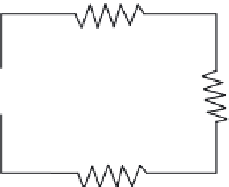Geoscience Reference
In-Depth Information
R
1
12 ohms
R
T
50 ohms
R
2
12 ohms
R
?
FIGURE 11.28
Calculating the value of one resistance in a series circuit.
Solution:
Given:
R
1
= 10 ohms
R
2
= 12 ohms
R
3
= 25 ohms
R
T
=
R
1
+
R
2
+
R
3
R
T
= 10 + 12 + 25 = 47 Ω
Equation 11.26 can be transposed to solve for the value of an unknown resistance; for example,
transposition can be used in some circuit applications where the total resistance is known but the
value of a circuit resistor has to be determined.
■
EXAMPLE 11.27
Problem:
The total resistance of a circuit containing three resistors is 50 ohms (see Figure 11.28).
Two of the circuit resistors are 12 ohms each. Calculate the value of the third resistor (
R
3
).
Solution:
Given:
R
T
= 50 ohms
R
1
= 12 ohms
R
2
= 12 ohms
R
T
=
R
1
+
R
2
+
R
3
R
3
=
R
T
-
R
1
-
R
2
R
3
= 50 - 12 - 12 = 26 Ω
Note:
When resistances are connected in series, the total resistance in the circuit is equal to the
sum of the resistances of all the parts of the circuit.
11.7.6.2 Series Circuit Current
Because there is but one path for current in a series circuit, the same current (
I
) must flow through
each part of the circuit. Thus, to determine the current throughout a series circuit, only the current
through one of the parts must be known. The fact that the same current flows through each part of
a series circuit can be verified by inserting ammeters into the circuit at various points as shown in
Figure 11.29. As indicated in Figure 11.29, each meter indicates the same value of current.



Search WWH ::

Custom Search